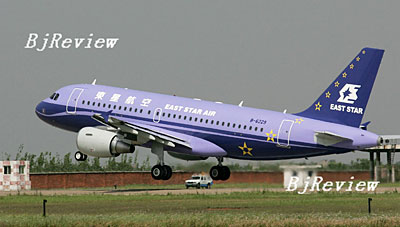
China's civil aviation administration was initially established by the Political Bureau of the CPC Central Committee as a subordinate organ to the People's Military Commission on November 2, 1949, one month after the People's Republic of China was founded. This started a new era in China's civil aviation industry.
On August 1, 1950, China formally launched its first two domestic air routes: one from Tianjin to Chongqing and the other from Tianjin to Guangzhou. The Sino-Soviet Civil Aviation Co. (SKOGA) was founded on July 1, 1950, as a joint airline and launched the country's first three international routes from Beijing to Chitta, Irkutsk and Alma-Ata in the former Soviet Union. The joint airline agreement was annulled on January 1, 1951, when the Soviet partner turned over its shares to China.
In 1950, China had only 12 domestic and international air routes, with total traffic turnover and passenger transport volume standing at 1.57 million ton-km and 10,000 people respectively. By 1957, China had had 27 domestic and international air routes, with the total traffic turnover reaching 15.34 million ton-km and the passenger transport volume hitting 68,500 people.
Statistics from the General Administra-tion of Civil Aviation of China (CAAC) show that after a half century of development, China's civil aviation industry boasted 1,336 routes covering a total mileage of 2.11 million km by the end of last year. Of these, 1,068 were domestic routes (including 43 routes to Hong Kong and Macao), leading to 140 cities nationwide, with the total mileage standing at 1.15 million km. The other 268 were international routes to 91 cities in 42 countries, with the mileage totaling 966,200 km.
In recent years, some private investors have taken interest in the civil aviation business and helped to enrich the air routes. There are a dozen private or joint-venture airlines with 39 aircraft and total registered capital of 2.6 billion yuan ($347 million) on the Chinese mainland currently. China's first private airline, Okay Airways Co. Ltd., made its maiden flight in March 2005. Yet, Li Xiaojin, a professor with the Civil Aviation University of China, thought there was more room for private airlines to expand. "A minimum of 20 aircraft are needed to guarantee profit for an aviation company, and the company should focus first on its size in order to bring about mass effect," said Li. "A majority of private airlines in China now use only one to three planes to fly one or two domestic routes and it's very difficult for them to make money."
Smooth flying ahead
On November 6, Wuhan-based private airline, East Star Airlines, launched its Wuhan-Hong Kong and Wuhan-Macao air shuttles. This was the first time for a domestic private airline to launch international routes.
The number of cities that need the CAAC's nod for launching new routes has decreased from 20 to 10, including Beijing, Shanghai, Guangzhou, Shenzhen, Chengdu, Kunming, Xi'an, Dalian and Hangzhou. They are cities playing host to the country's top 10 airports in terms of traffic. Other cities are looking for the green light from regional administrations and then have to register at the CAAC. It's the goal for the CAAC to free any city and any new route from going through the ratification process by 2010. After that, the only stipulation is registration.
It's stipulated in the Provisional Measures for the Administration of Flight Schedules of the Civil Aviation, which went into effect as of September 1, 2007, that flight schedules for newly launched routes enjoy priority during flight adjustment.
Fare wars
East Star Airlines, for example, made another move to slash prices after launching its international routes. It offers one scheduled shuttle flight every day between Wuhan and Hong Kong, and between Wuhan and Macao, with special offers for shuttle flights at 999 yuan ($133), forcing other companies to cut prices as well.
At present, various discounts are available for any tickets bought three or four days before the departure date in China. For destinations that cannot be reached by a direct single flight, passengers can choose joint flights to transfer, and the prices for joint air tickets for some routes are even cheaper than direct flights. In the off-season, traveling by air is almost as economical as traveling by train. China Eastern Airlines, one of China's three major aviation companies, once offered a substantial discount of up to 60 percent off the regular ticket for the Dalian-Beijing route, as cheap as 280 yuan ($37.3). The total price, covering the airport construction fee and fuel charges, was 350 yuan ($46.7), cheaper than the price for a cushioned sleeper seat-375 yuan ($50)-for an upper berth on a train from Dalian to Beijing.
Air companies have joined each other in slashing prices, something welcomed by customers. According to a survey by CARNOC.com, 87 percent of those surveyed considered price the major factor affecting their satisfaction with air transportation as well as their choice among different airline companies.
CAAC predicted that by 2020, China's total air transport turnover will exceed 150 billion ton-km, with passenger transport volume reaching 770 million people and cargo and mail transport volume hitting 16 million tons. The passenger transport volume in Beijing, Shanghai and Guangzhou airports will surpass 100 million people each. |
